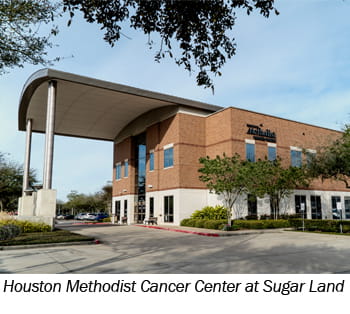Houston Methodist Sugar Land Hospital now offers a groundbreaking treatment option for skin cancer
Houston Methodist Sugar Land Hospital offers a new treatment to remove skin cancer by using a high-tech radiation delivery system rather than surgical removal, minimizing scarring and other side effects.

“This is a serious health issue that impacts more than two million Americans each year,” said Clive Shkedy, M.D., a board-certified radiation oncologist and medical director of the Houston Methodist Cancer Center at Sugar Land. “Older generations didn’t always recognize the damaging effects of the sun and as a result, we are seeing an increasing number of skin cancer cases as the population ages.”
The traditional treatment for skin cancer is surgical removal, typically by a dermatologist or primary care physician. Cryotherapy – using liquid nitrogen to freeze and kill the cancerous tissue – is also an option.
But those therapies, while effective, can cause scarring and other complications for patients with tumors in cosmetically sensitive areas, such as the nose or near the mouth, and often require additional skin grafting procedures. Surgery also poses risk for patients with health issues, such as those on blood thinners or individuals with compromised healing systems due to diabetes or peripheral artery disease.
That’s why doctors at Houston Methodist Sugar Land are using a technology called high-dose radiation (HDR) brachytherapy to treat skin cancers in some patients with early-stage tumors.
“Treating skin cancer with radiation isn’t new; X-ray machines designed to treat lesions were commonplace in the 1970s and ’80s,” said Shkedy. “But HDR brachytherapy is far more sophisticated and well-suited to skin cancer than other forms of radiation therapy. With today’s technology, we can deliver a precise, customized radiation dose directly to the surface of the cancer, which spares surrounding tissue and minimizes many of the side effects of traditional treatment forms, such as scarring. HDR brachytherapy is also pain-free and requires no needles, incisions or sutures. This technology gives us a valuable tool to treat skin cancer effectively and with minimal disruption to patients’ lives.”
“For example, we had a patient with skin cancer across his cheeks and nose. He would have had to go through reconstructive surgery for his nose had he not chosen to go with radiation,” said Shkedy. “The benefits of having HDR brachytherapy greatly outweighed other options. He was on blood thinners which could not be stopped because of his other health issues. Brachytherapy was the ideal treatment.”
The high-dose treatment requires twice-weekly sessions that last just a few minutes, usually for four weeks. That’s compared to the seven-week treatment regimens that traditional radiation requires. With HDR brachytherapy, physicians can utilize a variety of applicator tools to customize radiation delivery quickly and easily to complex locations, such as the nose or ear.
“HDR brachytherapy combines a number of diagnostic, planning and radiation delivery technologies into one highly effective therapy,” said Shkedy. “Within a month, we can successfully remove many skin cancers without scarring or other complications and without the need for future skin grafts. It’s a breakthrough that will make a difference for many patients.”
The Houston Methodist Cancer Center at Sugar Land is the only American College of Surgeons/Commission on Cancer-accredited hospital in Fort Bend. To learn more about our cancer services, visit houstonmethodist.org/cancer-sl, or call 281.242.2873. Or visit our Facebook page at fb.com/methodistsugarland for the latest news, events and information.
